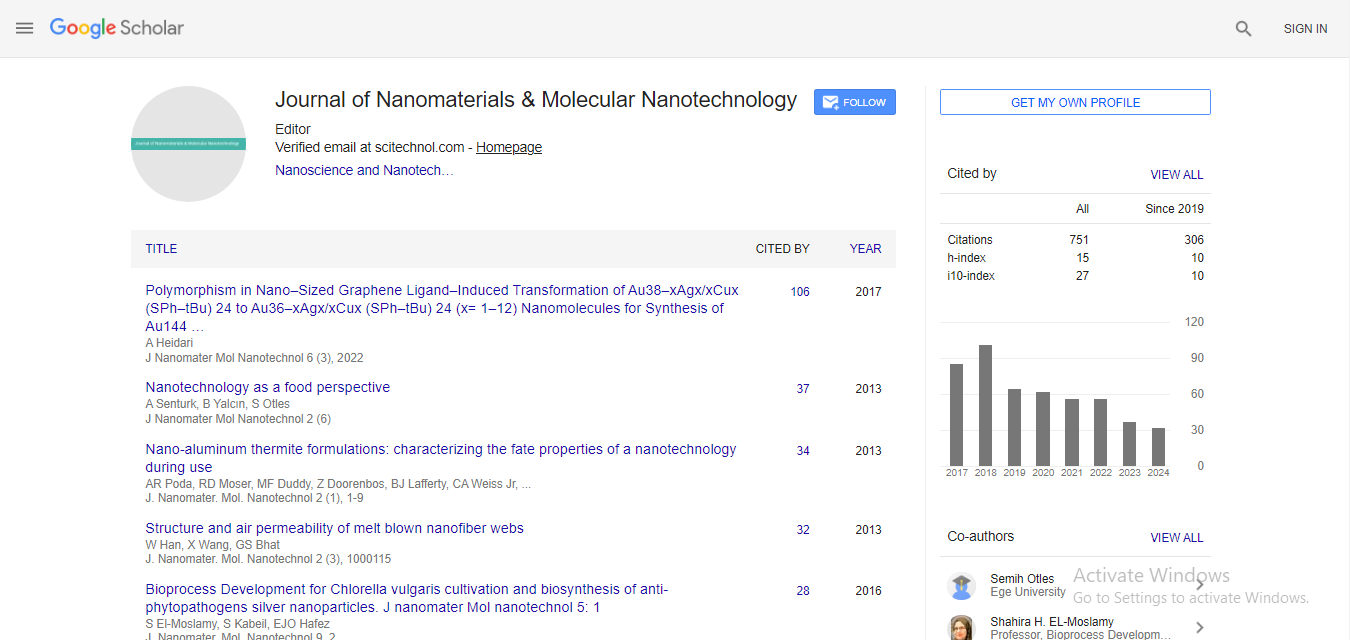Perspective, J Nanomater Mol Nanotechnol Vol: 11 Issue: 1
Polymer Nanocomposites Made Using Functionalized Graphene Sheets
Zarshad Ansari *
Department of Mechanical Engineering, Middle East Technical University, Ankara, Turkey
*Corresponding author: Zarshad Ansari
Department of Mechanical Engineering, Middle East Technical University, Ankara, Turkey
E-mail: ansarizarshad@gmail.com
Received date: 22 December, 2021, Manuscript No. JNMN-21-58132;
Editor assigned date: 24 December, 2021, PreQC No. JNMN-21-58132 (PQ);
Reviewed date: 07 January 2022, QC No. JNMN-21-58132;
Revised date: 14 January, 2022, Manuscript No. JNMN-21-58132 (R);
Published date: 21 January, 2022, DOI: 10.4172/2324-8777.2022.11(1).1000320
Citation: Ansari Z (2022) Polymer Nanocomposites Made Using Functionalized Graphene Sheets. J Nanomater Mol Nanotechnol 11:1.
Keywords: Nanocomposites
Description
Polymer based composites were heralded in the 1960s as a new paradigm for materials. By dispersing strong, highly stiff fibers in a polymer matrix, high-performance lightweight composites could be developed and tailored to individual applications. Today we stand at a similar threshold in the realm of polymer nanocomposites with the promise of strong, durable, multifunctional materials with low nanofiller content. However, the cost of nanoparticles, their availability and the challenges that remain to achieve good dispersion pose significant obstacles to these goals. Here, we report the creation of polymer nanocomposites with functionalized graphene sheets, which overcome these obstacles and provide superb polymer particle interactions. An unprecedented shift in glass transition temperature of over 40°C is obtained for poly (acrylonitrile) at 1 wt% functionalized graphene sheet, and with only 0.05 wt% functionalized graphene sheet in poly (methyl methacrylate) there is an improvement of nearly 30 °C. Modulus, ultimate strength and thermal stability follow a similar trend, with values for functionalized graphene sheet poly (methyl methacrylate) rivaling those for single-walled carbon nanotube poly (methyl methacrylate) composites.
Various additives are added to plastics to improve processability, change product properties or protect them against thermal, UV or light influences. In the case of a polymer nanocomposite, the additives have at least one dimension of less than 100 nm and can be found in the form of platelets, fibers or particles. They primarily serve to improve tensile strength, thermoform ability, flame retardancy, optical and electrical properties, and the barrier properties of the plastic into which they are incorporated. Nanoadditives include layered silicates such as montmorillonite, carbon-based additives, nanoscale metal oxides, metals, or organic additives such as nanocellulose or lignin nanoparticles. In addition to reductions in resources and weight, nanoadditives also have the potential to replace harmful substances such as environmentally problematic halogenated flame retardants. Across the world, polymer nanocomposites are already being used in packaging materials, the automotive industry and transportation, aerospace and energy technology, as well as in sporting goods.
Mechanical Properties
However, company surveys in the Austrian automotive and electronics industries have shown that nanoadditives currently only play a marginal role in these sectors. The main reasons are problems with dispersibility, large-scale production, high costs, and uncertainty around their impact on humans and the environment. Layered silicates, such as kaolin, talc or montmorillonite, are naturally occurring clay minerals and are amongst the most frequently investigated nanomaterials for the production of polymer nanocomposites.3 Montmorillonite in particular is the subject of numerous research projects and are already used commercially. Nanoscale montmorillonite is a sodium aluminum silicate and also called nanoclay because these layered silicates have at least one dimension in the nanometer scale. The thickness of the platelets is only one to a few nanometers, the length spanning from several hundred to thousands of nanometers. The mechanical properties of plastics, such as tensile and impact strength as well as heat distortion resistance, can be improved by adding layered silicates. In addition, such polymer nanocomposites exhibit high resistance to chemicals and good barrier properties to gases.
Nanoclays, which are added to, for example, polypropylene or polylactic acid packaging films, prevent the diffusion of oxygen or flavourings and thus prolong the shelf life of foods. Layered silicates occur naturally in large quantities and can also be produced synthetically at low cost. A homogeneous distribution of the platelets in the plastic matrix is crucial for improving the properties. For this, the platelets, which are naturally present in the form of packages, need to be surface-modified to facilitate the separation of the individual platelets (intercalation or exfoliation) and thus their dispersibility. The high aspect ratio of the platelets, the very small thickness in relation to width and length, results in a large interface between matrix and silicate so that only a few weight percent are sufficient to significantly improve the mechanical properties of the composite compared to the pure plastic. For example, the tensile strength of polystyrene/ montmorillonite composites can be increased by 70%-560%depending on particle distribution and surface treatment.
Volatile Degradation
Polymer layered silicate nanocomposites are already used in packaging materials such as plastic bottles for carbonated beverages. Car parts such as timing belts, body parts and fuel tanks have been made of a polyamide montmorillonite composite material (nylon-6) since 1993. Especially in the automotive and aeronautics industries, weight reduction plays an important role in reducing fuel consumption. In the production of body parts, the use of polymer composites reinforced with nanoclay instead of steel promises possible advantages in order to save energy and reduce CO2 emissions. Montmorillonite can also reduce the flammability of polymer composites, which is why such composites are also suitable for the manufacture of products that have higher flame protection requirements. Layered silicates thus have the potential to replace or at least reduce the use of environmentally problematic FRs such as halogenated compounds when used in combination with other FRs. For the flame-retardant effects to emerge, the formation of a thermally insulting crust layer that is only slightly permeable for volatile degradation compounds is pivotal. Bio-based plastics, for instance made of starch, are sensitive to moisture and often have poor mechanical properties. The addition of nanoclay can improve the properties considerably and even accelerate the disintegration or decomposition of biodegradable plastics, as first investigations.
Polymer nanocomposites are being used in packaging, sports equipment, automobile sector and bio medical applications due to their exceptional property combinations and distinctive design feasibility. So keeping these property enhancements polymer nanocomposites has received greater attention in both academic and industrial areas. This paper reviews the various methods for dispersion of nanofillers, their coating on fibers and corresponding properties improvement. Unlike composites these enhancements in properties can be achieved without increase in density as very small amount 1%–5% of nanoparticles are loaded. Study reveals that incorporation of different Nano reinforcements such as layered silicate clays, carbon nanotubes, nanowires and silica nanoparticle nanocomposites into elastomers possess high surface to volume ratio of the reinforcing phase, high aspect ratio and intercalation/exfoliation characteristics which causes properties up gradation such as modulus, strength, durability, toughness and barrier to gases when compared to traditional materials. In addition to property enhancements they are environmental friendly also. Although they provide great benefits but still manufacturing them in terms of quantity and quality will be one of the biggest challenges.
 Spanish
Spanish  Chinese
Chinese  Russian
Russian  German
German  French
French  Japanese
Japanese  Portuguese
Portuguese  Hindi
Hindi 



